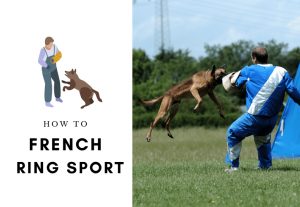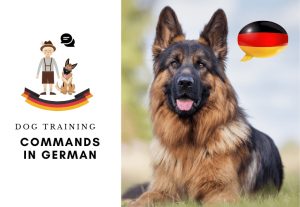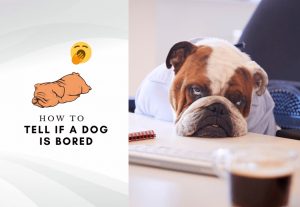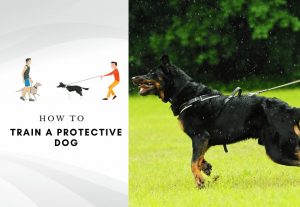Do not for a moment think that humans are the only athletes on the planet. Gone are the days when sports were known to be a HUMAN-ONLY trait.
Now the game has changed.
If you own an agile dog, you’ll agree that our fur-friends are second to none, right?
Don’t possess a dog?
You must have seen dog sports like French Ring Sport, Belgian Ring Sport, and Schutzhund. Have you?
All these sports are the most favorites of every dog fancier.
Dogs are ultimate sports heroes. They amaze us with their physical aptitude, thrill us with their prodigious skills, and inspire us with their dedication towards sports.
Unlike other dog protection sports, French Ring Sport has a different philosophy.
In this article, we aim to talk about the non-identical tenets of French Ring Sports, its attitude, training methods, and tools.
Ready to dive into details? Let’s roll!
What Is a French Ring Sport?

Fast and intense, French Ring Sport is a protection dog sport brimmed with high-performance jumps, intense obedience, and spine-tingling speed combats between a dedicated dog and a more dedicated owner.
French Ring Sport is one of the most exciting dog sports in America for some reasons. It’s a technical protection sport and a challenge in the canine world like nothing on earth.
Originated in France, the sport emerged as a unique way to accurately test potential breeding stock for working ability.
This Ring Sport is evolving for more than a hundred year, and the surge in the numbers of trials giving clubs in every year it’s attracting more and more aspiring participants.
Protection sports like French Ring test a dog’s ability to protect himself and his handler. But they also go beyond checking the protectiveness of a dog.
How?
These sports focus on evaluating the overall temperament of the canine.
Titles:
Not every dog can participate in this thrilling contest, there are few limitations. It starts with an initial temperament test that shows the dog has the correct mind and body suitable to work through the rest of the sport.
Your dog has to qualify a test called CSAU, Certificat de Sociabilité et d’Aptitude à l’Utilisation (Certificate of Sociability and Aptitude for Work), normally known as Brevet. It’s a 15-minute test, brief but difficult.
Once your dog qualifies, French Ring Sport has three further levels:
- Ring I,
- Ring II,
- Ring III.
With each advancing stage, the dog is introduced to more difficult situations in the number and the complexity of exercises. The trials include three different sections, jumps, obedience, and protection.
Different Roles in The Field:
The dog, the handler, and the decoy are the immediate players. And of course, there’s a judge who may have a trial secretary or deputy judge with him who directs the handler and the dog.
The judge is in charge of the whole sport. He organizes the selection of the order of the exercises.
The judge, the referee, and a scorekeeper run the show.
Lots of dog fanciers take their seats in the crowd to cherish the great dog moments.
The sport consists of a series of tests of the dog and his handler and a decoy. The real competition is between the dog and the decoy.
The handler is mostly the owner of the dog. And a decoy is the person with a protective bite suit on. A decoy aims to wear down the dog physically and psychologically.
Faster and more alert – the decoy will do anything to score more points but within the permitted scenario and avoiding physical brutality.
Limitations:
Ring sport is NO child’s play!
It already demands hell dedication, but to spice up the sport there come some limitations as well. For instance, the dog has no leash or collar on except during the “Heel on leash”. Also, no food rewards or physical corrections are permitted.
Simply put, no praise and no petting! Else, you’ll lose general outlook points.
Beware! You may also fail to retain the points if you use multiple commands, incorrect commands, or if you or the dog fail to perform exercises.
Points have no connections with style, attitude, courage, or value judgment. Opinions and interpretation don’t influence your scoring; your dog will get the points for his performance.
Fair and square!
What Are The Different French Ring Exercises?

French Ring Sport comprises three different stages of exercises: jumping, obedience, and protection.
Mostly, the exercises flow in the same order however, within each discipline the sequence of exercises may differ.
The number of exercises and their difficulty level also varies according to the level of competition.
The higher the level, the more difficult the exercises!
1. Jumping:
The jumping or agility stage is for the dogs who qualify for Ring I or above. The stage comprises the hurdle, the palisade, and the long jump.
In French Ring I, the handler has the freedom to select any of these three options, but as the dog qualifies for the next ring, going over all three jumps is a MUST!
- The Hurdle: The dog has to jump over a collapsible hurdle that can be toppled if touched. The height of the hurdle ranges between 0.9 m to 1.2 m according to the level of competition. The dog jumps twice, once away from its handler, and then returning to the handler. The points are earned on the base of height jumped.
- The Palisade: Now, the dog has to climb over a SOLID wooden wall. Again, the height of the wall depends on the difficulty level and usually ranges between 1.7 m to 2.3 m. Just like the hurdle jump, the dog has to climb over the wall twice, away from the handler, and get back towards the handler.
- The Long Jump: It’s a long, but low jump and the dog must clear it without bumping into the teething key placed at the end. The distance of this jump lies somewhere between 3.5 m to a 4.5 m maximum.
And yes, according to the level of the sport!
2. Obedience:
The category comprises heel on leash, heel with a muzzle, long stay, thrown retrieve, seen retrieve, unseen retrieve, food refusal, positions, and send away.
- Heel on the leash: Out of all French Ring Exercises, Heel on the leash is the only exercise that allows your dog to wear a collar. For this exercise, there are pre-set patterns. Your dog has to heel at your side, stopping and starting at the judge’s horn.
- Heel with a Muzzle: The leash or collar is removed. Now, the dog wears a muzzle. Performing conditions for the dog are as similar as in the ‘Heel on leash’ the only exception is that the dog has to wear the muzzle without showing any resistance.
- Long Stay: The handler goes out of sight and the dog has to stay long in any position, either sit or down, for one minute according to the level.
- Thrown Retrieve: The exercise is for FR I and above.
The handler throws an article such as gloves, glasses case, or socks, and the dog must retrieve it, come back to the handler, sit, and release, but upon command only. - Seen Retrieve: In this exercise, first, your dog heels by your side until you drop an article. The retriever fetches it without any command. He comes around and presents the dropped article. The exercise is for FR II and above.
- Unseen Retrieve: This time, the dog, again, heels by the handler’s side. The handler drops an article unseen by the dog, and they both walk away. Meanwhile, an identical article is placed near the handler’s article.
When the judge gives a horn signal, the handler stops and sends back the dog to retrieve the article he/she dropped. Unseen Retrieve is an exercise of FR III. - Food Refusal: This is a real-time challenge. The handler is sent out of the site while the dog stays. To make it tougher several tempting pieces of food are placed throughout the field. The dog has NOT to touch any of them throughout the competition.
- Positions: As the competition commences, position orders are drawn in a painted box on the ground. From 18m away, the handler commands his dog to change the position. Not only the dog has to take the commanded position but has to stay within the painted box.
- Send Away: Upon command, the dog has to run away from the handler in a straight path and must return instantly when called back. It’s an FR III exercise.
3. Protection:
The protection level includes: Face attack, flee attack, defense of handler, attack with the revolver, search and escort, stopped attack, and guard of the object.
- Face Attack: The handler, from a distance, commands the dog to attack the decoy. Upon the next command, the dog should stop biting and must return to the handler immediately.
- Flee Attack: The decoy attempts to flee away, and the handler commands the dog to attack the fleeing decoy. When commanded to come back, the dog must stop and return to the handler. (For FR I and above)
- Defense of Handler: The decoy physically attacks the handler and urges the dog to attack him. The dog must attack the decoy to defend the handler without any command. When commanded, the dog stops attacking the decoy but doesn’t let him go until he’s called back to the handler.
- Attack with Revolver: The decoy confronts the dog and the handler with a revolver from a distance. The dog is commanded to attack the decoy. Then, the judge signals the handler to command the dog to stop biting and guard the confronter. The decoy makes an escape attempt, but the dog must stop him without the command. It’s repeated. Then, the handler comes and disarms the decoy and heels off the dog. (For FR I and above)
- Search and Escort: The dog departs the field, and the decoy hides in any of the six blinds there. When the dog returns, he, on command, searches for the decoy across the field. Once found, the dog must bark to notify, not bite.
If the decoy tries to flee, the dog must stop him by biting.
Now the handler will come and disarm the decoy, the dog’s job now is to guard the decoy. He doesn’t have to bite until the decoy makes another attempt to escape. After three such escape attempts in escort, the dog will keep on guarding the decoy, and the handler will take the gun away and will return to collect his dog.
This exercise is for Ring II and above. - Stopped Attack: It’s similar to the Face Attack exercise. The EXCEPTION is, when the dog is within 1-4m of the decoy, the handler calls his dog back. The dog must return immediately without biting the decoy. (For Ring III)
- Guard of the Object: The handler leaves a basket within a marked circle on the field, asks the dog to guard it, and goes out of the site. The decoy tries to steal the basket thrice. The dog must protect the object each time.
As the decoy gets away, the dog must return to guard the object without any command. (For Ring III)
French Ring Vs Schutzhund: What’s The Difference?
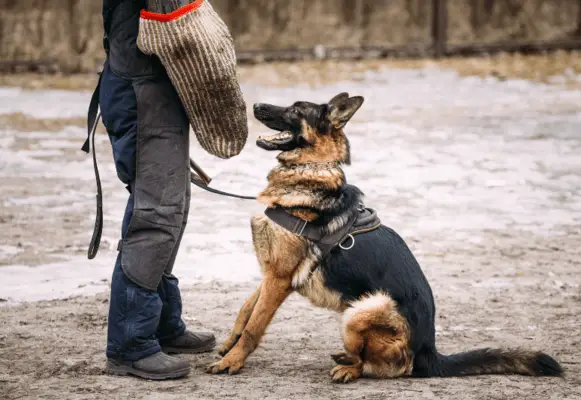
The major differences between French Ring Sport and Schutzhund are a few. In the French Ring, there is no tracking, the decoy wears a full-body suit, the dog can bite anywhere on the suit, the order of exercises is arbitrary, and when the team walks on the field they complete all three parts (agility, obedience, and protection) and leave the field.
On the other hand, the Schutzhund has tracking, the decoy wears a sleeve only, and the trial is broken up into three sections: tracking, obedience, and protection. Each section is performed with a break in between.
What Are Some Best French Ring Dog Breeds?
By now, you must have had the idea that not every dog breed is compatible with the challenging nature of the game.
You are right!
The dog breeds that compete in French Ring or are used in demanding situations of real-life are by no means ordinary.
They are carefully bred with selective-breeding for years, and then, with the right qualities and right temperament, they take the stage in the protection games like French Ring.
The breeds you’ll often see competing in the rings are Belgian Malinois, Dutch Shepherds, and German Shepherds.
Rottweilers, Dobermans, and American Bulldogs also perform pretty decently in the ring.
French Ring Sport Commands:

Besides basic commands, like Sit or Down, French Ring Sport has a whole list of set commands (in French). Below you can see the said list.
| English | French | Usage |
| Sit | Assis | To command a dog to sit (trial) |
| Down | Couché | To command a dog to down (trial) |
| Stand | Debut | To command a dog to stand (trial) |
| Heel | Au pied | To command a dog to heel (trial) |
| Come here | Vien ici | To command a dog to the front (training) |
| Wait | Reste | To command a dog to wait (trial) |
| Stay | Pas bouger | To command a dog not to move (trial) |
| Jump | Saute Aller | To command a dog to jump (trial) |
| Bark | Abois | To command a dog to bark (training) |
| Bite/Attack | Attaque | To command a dog to bite (trial) |
| Guard | Garde | To command a dog to guard an object or person (trial) |
| Hold | Tenir | To command a dog to hold an object (training) |
| Give | Donne | To command a dog to give an object (trial) |
| Go out | En avant | To command a dog to run in a direction (trial) |
| Out | Hault | To command a dog to release (trial) |
| Back up | Recule | To command a dog to back up (training) |
| Return | Retour | To command a dog to return (training) |
| Place | Place | To command a dog to place (trial) |
| Don’t touch | Pas touché | To command a dog not to touch something (training) |
| Search and bark | Cherche abois | To command a dog to search for the decoy and bark when found (trial) |
| Search and bring | Cherche apporte | To command a dog to search and bring an object (trial) |
| Object | Objet | To command a dog to go to an object (training) |
| The paws | Les pattes | To command a dog to place their paws in something (training) |
| Bye | Bye/ au revoir | To command a dog to move into place on the defense of handler (training) |
| Hello | Bonjour | To command a dog to sit when meeting the decoy (training) |
How to Train a Dog for French Ring?

Train your dog for French Ring Sport if you think your dog must taste the victory and enjoy the fame as it’s the most demanding dog sport. Ready for the hard work?
Start immediately!
Stage 1: Jumping
Hurdles: Start hurdle training by commanding your dog to jump over hurdles of low height. Once he is used to climbing over them, increase the height gradually.
You can also lure your dog for hurdle training by offering some tasty treats on the other side of the barrier. Thanks to their love for treats!
Palisades: Start training your dog for palisade with a lower level, but of course, much higher than the hurdle. To motivate your dog, you can also take help from a helper to hold a toy (your dog is crazy for) on the other side of the palisade frame.
Place your dog near the frame so that he gets an idea of what he is supposed to do. Teach him the commands to go up, stay, and get down. Also, train him not to jump off the palisade frame.
Once he masters the commands and the height of the frame, you can increase the height.
Long jumps: When your dog becomes a pro on hurdle and palisade, he can endure the long jump easily. For broad jump training, consider using an obstacle of lower height in the upright position.
The vertically placed barrier will encourage your dog to jump over it. Again, when your dog is used to a certain height, increase it.
Stage 2: Obedience
Heel on the leash: Heel on the leash requires nothing but obedience. Put your dog’s leash on. Keep your dog on your left. Now, hold the end of the leash in your hand at a distance comfortable to your dog. Hold the rest of it in the other hand. Make sure the leash should have no tension.
Walk around with your dog, command him to sit, and keep the drill going on until your dog learns the obedience.
Long stay: Ask your dog to sit first. Keep your entire focus on the dog and command him to stay. Initially, keep stay-time minimal and slowly increase to the extent you want.
Thrown Retrieve: Start with throwing objects your dog will love going after. Command him to catch. When your dog successfully brings the object back, start introducing him to some small hurdles.
Food refusal: Place dog-food in front of your pooch. When he comes to nibble at his treat, strictly command him not to eat.
It will take some time and patience, but your dog, for sure, will learn how to resist sooner or later!
Stage 3: Protection
Defense of Handler: Develop alertness. Teach your dog to bark when required and teach him the ‘attack’ command in a stronger tone. When your dog successfully learns the attack command, you can teach the ‘back off’ command to calm him down.
Search and Escort: for teaching the ‘search’ command, an ideal way is to take someone as a helper. Ask the helper to drop his article and make your dog follow and search for it.
Best Tools to Train a Dog French Ring:

Before you start to train your dog for French Ring, organize your training supplies. Here are some best tools you might want to keep in your arsenal.
1. Viper Multi Level Dog Bite Sleeve
- THIS SLEEVE MUST BE USED WITH COVER.
- 3-Level Adjustable Bite Bar. Used for Green, Intermediate or Advanced Dogs
- Layers can be removed or added as needed
- Ballistic nylon sleeve finish
- Optional sleeve covers come with poly liners to extend the life of the sleeve
Prices pulled from the Amazon Product Advertising API on:
Product prices and availability are accurate as of the date/time indicated and are subject to change. Any price and availability information displayed on [relevant Amazon Site(s), as applicable] at the time of purchase will apply to the purchase of this product.
This is a protection bite sleeve that covers your arm from a 360-degree angle. It saves you from every possible accidental bite. Moreover, the bite bar has three adjustable levels; for a green dog, intermediate, and high-level biters.
Want to extend your sleeve’s life? Use it with covers!
2. MelkTemn Professional Dog Bite Training Set
- ★DURABLE&STRONG: Made of strong jute outer layer, thick foam inner layer and inside foam cover handle,provides the necessary support and protection from hard bites.
- ★TRAINING: This training kit is perfect for professional trainers and beginners training dogs. It can be used both on right and left arms. interlayer is thick & soft pad, easy to put on and take off even wearing thick clothes.
- ★DESIGNED FOR YOUNG DOG : Designed for puppy young dogs, 12 months old and younger work dogs ,entry level dog training, such as Malinois Police K9 German Shepherd Mastiff and so on.The wide surface of sleeve encourages puppies to open their mouths and take a full bite.
- ★DIMENSIONS: Bite Sleeve Size 23.6*11.8(60*30cm); Stick Size 22.4*1.1( 57*2.9cm).
- ★ INSIDE UPGRADED STRONG HANDLE : The inside handle is engineering wood with soft and anti-slip handle coating which is stronger but lighter than steel handle for holding the whole sleeve for heavy duty biting training.
Prices pulled from the Amazon Product Advertising API on:
Product prices and availability are accurate as of the date/time indicated and are subject to change. Any price and availability information displayed on [relevant Amazon Site(s), as applicable] at the time of purchase will apply to the purchase of this product.
This durable and strong bite training set is padded from the inside. The embedded handle is just accurate for holding the set throughout the training. It’s a great training tool for training puppies.
3. K9 to 5 GEAR Dog Tug Toy Bite Pillow
- TUG OF WAR DOG TOY for developing strong dogs and bonding through exercise toys.
- 2 SOFT ROPE HANDLES for a comfortable and easy grip, full control and stability.
- HIGH QUALITY AND DURABLE TOY with double stitching and a tough biting sleeve surface made of jute.
- TRAIN AND BOND OUTDOOR WITH YOUR DOGS like German Shepherd, Malinois, etc. Schutzhund IPO Equipment.
- Please follow instructions (see description) to ensure the large toy lasts. (NOT A CHEW TOY)
Prices pulled from the Amazon Product Advertising API on:
Product prices and availability are accurate as of the date/time indicated and are subject to change. Any price and availability information displayed on [relevant Amazon Site(s), as applicable] at the time of purchase will apply to the purchase of this product.
Train your dog to strengthen his tugging skills and improve the bonding with this tug toy. Make sure that your dog bites the pillow portion, not the handles, for the handles are only for providing a good grip.
4. PET ARTIST Dog Anti-Grab Scratch Training
- ▶The high quality scratch apron is created from heavy duty canvas material out layer and soft padded sponge cloth lining,comfortable,yet remains lightweight for the wearer
- ▶Stitched together with high quality grade thread
- ▶Apron style,very easy to put on and training off,suitable for hot day training
- ▶One size:Height:40’’,adjustable waistline:43-48’’, feel free to match any training supplies for a variety of training occasions,great for dog training involving Schutzhund, Police K9, and personal protection work
- ▶100% Quality Guarantee:We guarantee to replace new items or refund total money for free if you are unsatisfied with our products or quality. Just enjoy your shopping experience
Prices pulled from the Amazon Product Advertising API on:
Product prices and availability are accurate as of the date/time indicated and are subject to change. Any price and availability information displayed on [relevant Amazon Site(s), as applicable] at the time of purchase will apply to the purchase of this product.
For Anti-Grab scratch training, you can rely on this apron. It’s made of heavy-duty but comfortable material and has an adjustable waistline. The canvas material is layered and padded, but you can use it on hot days as well.
5. RAPICCA Animal Handling Gloves
- EXCELLENT BITE PROOF: RAPICCA Leather Animal Handling Gloves is made by Top Grain Leather and reinforce Kevlar Double Leather Finger Palms & Backs, provide an excellent bite-proof function from small animal for your hands and Forearm.
- SUPERIOR SECURITY FOR FORERAMS - The 16 inches extra long glove with 7.5 inches long sleeve protect your Fingers and Forearm from Animal bite, Cat scratch, Parrot grabbing, Eagle grabbing, Snake bite etc.
- THICK AND DURABLE - RAPICCA Leather Animal Handling Gloves are made from carefully-selected thick and soft shoulder split natural cowhide leather which is Puncture Resistant, Cut Resistant, Bite Resistant, Heat Resistant, Oil Resistant and Fire Resistant. This pair of heavy duty gloves will last for a long time.
- USED By: Veterinarians, Animal Control Staff, Groomers, Kennel Workers, Zoo Workers, Pet Shop Employees, Breeders/Handlers, Pet owners, Bird handlers, Reptile handlers
- MULTI - FUNCTION FOR MEN & WOMEN - They are not only for Animal Handling but also useful for many other work and home tasks. Idea for Grill, Barbecue, Stove, Oven, Fireplace, Cooking, Pruning flowers, Gardening, Camping, Campfire.
Prices pulled from the Amazon Product Advertising API on:
Product prices and availability are accurate as of the date/time indicated and are subject to change. Any price and availability information displayed on [relevant Amazon Site(s), as applicable] at the time of purchase will apply to the purchase of this product.
Protect your forearms with RAPICCA gloves. They are made with thick yet soft leather that withstands dog bites, weather conditions, and other wear and tear situations well.
If your dog is an aggressive biter, you won’t find any better product than this.
6. TINTON LIFE 39.2″ Leather Dog Protection Training Whip
- Genuine leather humanmade fashion whip used for any pets, high quality so can be used for a long time
- Ergonomic metal handle match your hand perfectly, lightweight
- Can be bended as you want, never morph
- Can be used with dogs of any size, also works great as a training tool and provides the mental exercise dogs need
- Size: whole length 39.2
Prices pulled from the Amazon Product Advertising API on:
Product prices and availability are accurate as of the date/time indicated and are subject to change. Any price and availability information displayed on [relevant Amazon Site(s), as applicable] at the time of purchase will apply to the purchase of this product.
TINTON dog protection training whip is a great training tool to provide mental exercise your dog needs. It’s bendable and very effective for discipline. It is equally beneficial for dogs of all sizes.
FAQs:
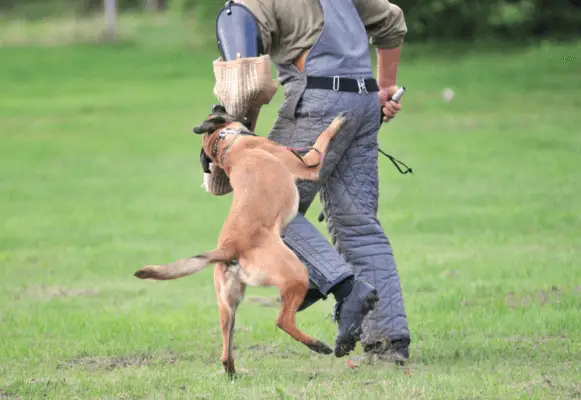
Q1. What Is a French Ring Sport?
French Ring Sport is an exhilarating dog protection sport that is the most similar to Belgian Ring, Mondio Ring, and Champagne. Also, it has some similarities with Schutzhund and KNPV.
Q2. What Are The Seven Basic Dog Commands?
The seven basic commands you can start training your dog with are:
Sit, Stay, Down, Come, Heel, Off, and No.
Q3. What Is a French Ring Training?
French Ring dog Training is actually shaping your canine’s behavior and temperament to earn lofty titles of French Ring Sport.
Conclusion:
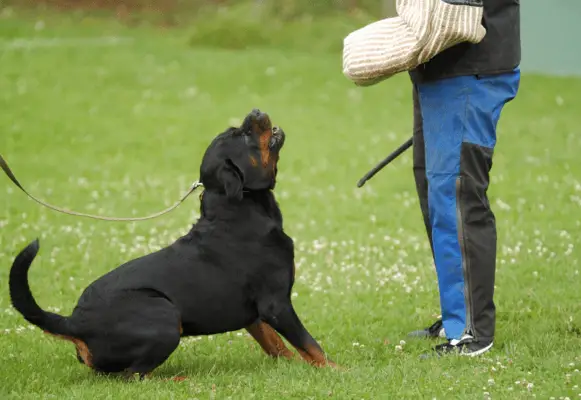
Now when you have a better sense of the game, its goals, rules, challenges, and the sports’ fame is also in full swing, you must be willing to participate with your dog.
Wait no further! There’s so much to work on, commands, training, tools, and much more.
So, go ahead, keep the greatness of sport in mind, and start training your dog with the most possible dedication right away!
Appreciate his athletic brilliance. Cherish his every amazing move. Use every suitable technique to step up the game, and your dog will be the most athletic pupper you ever did see.
Cheers!

